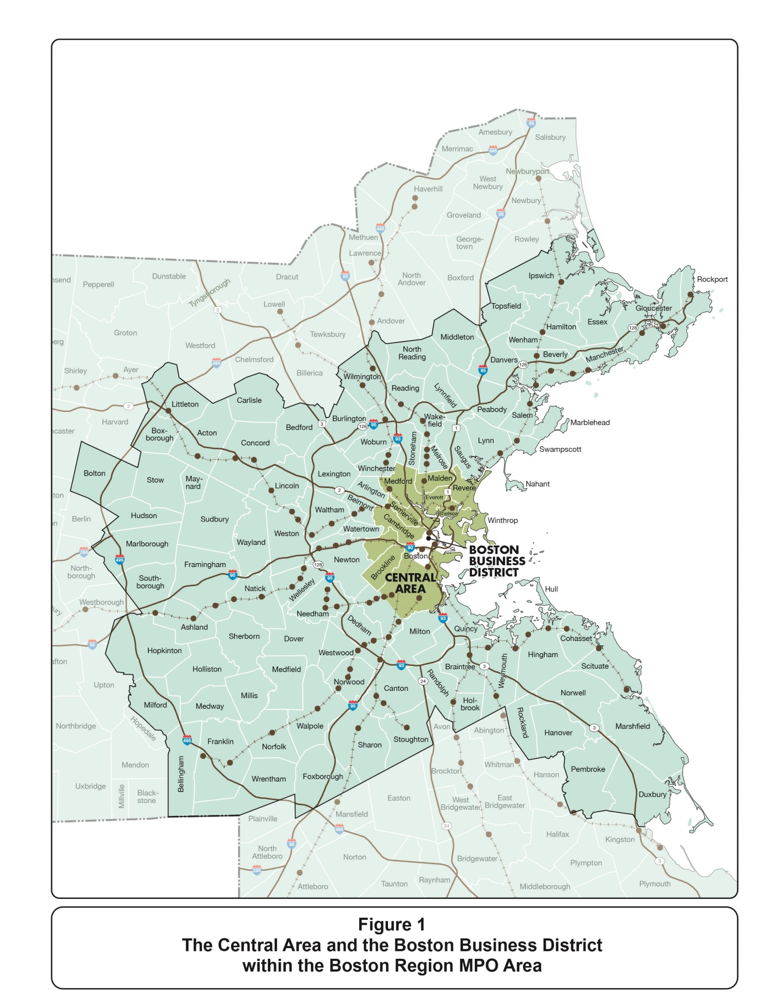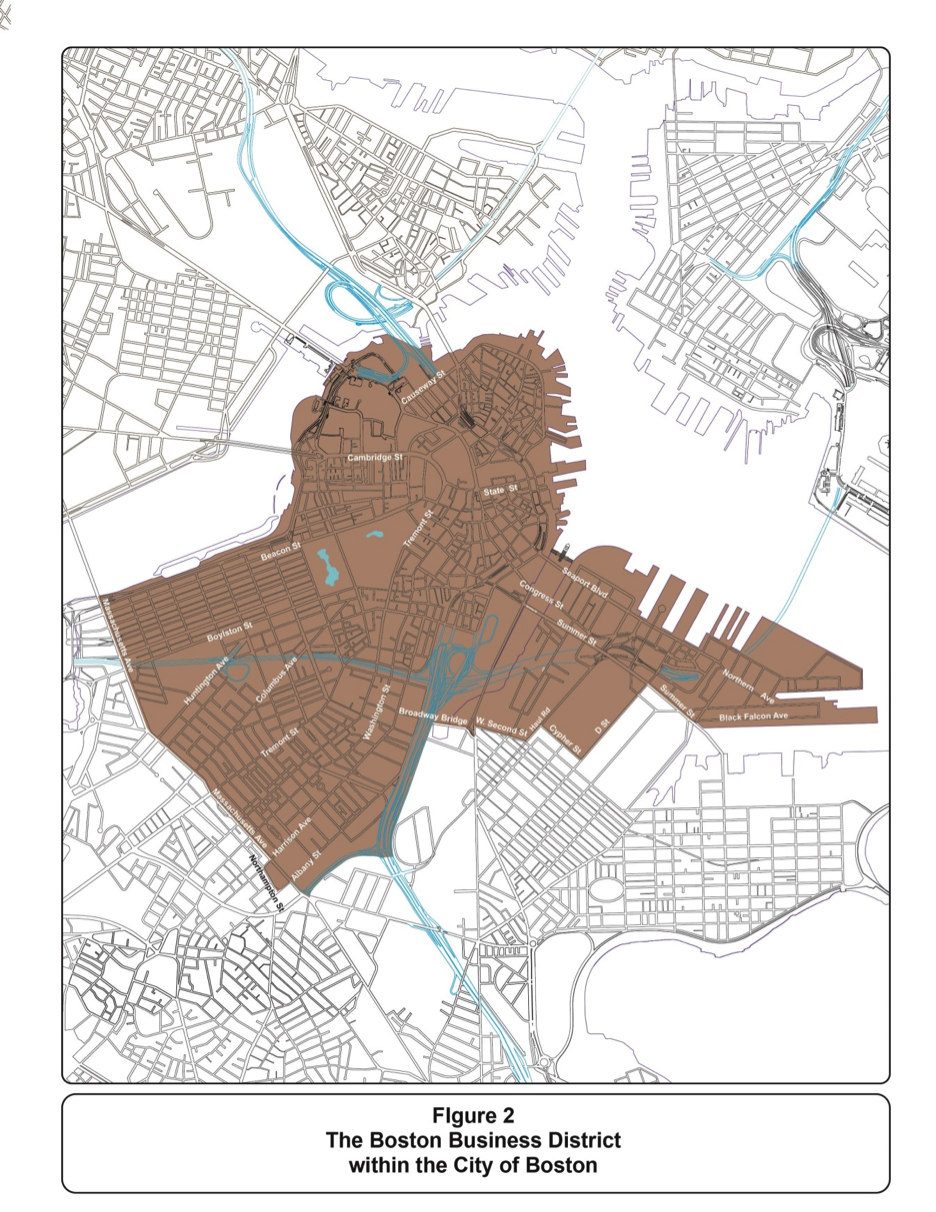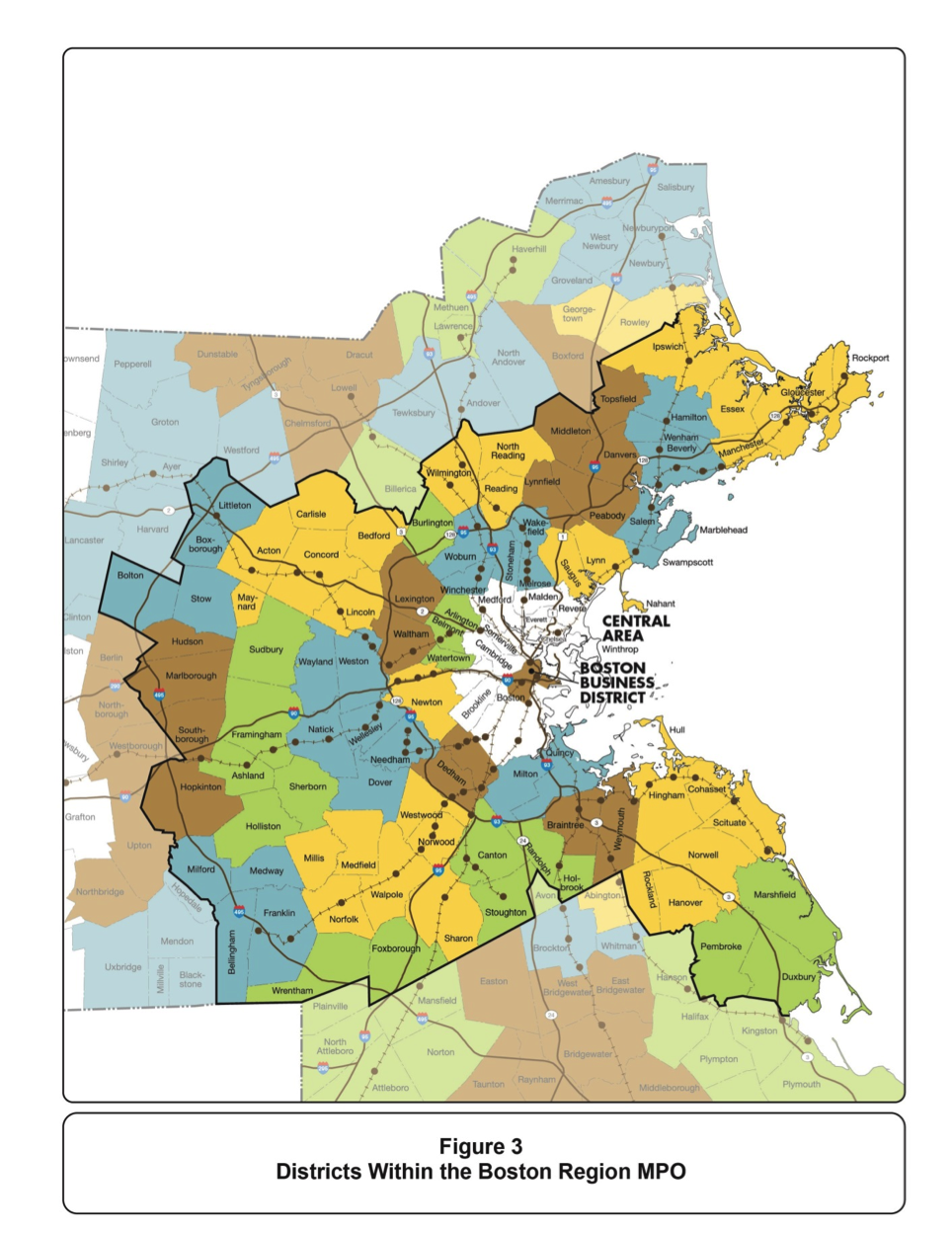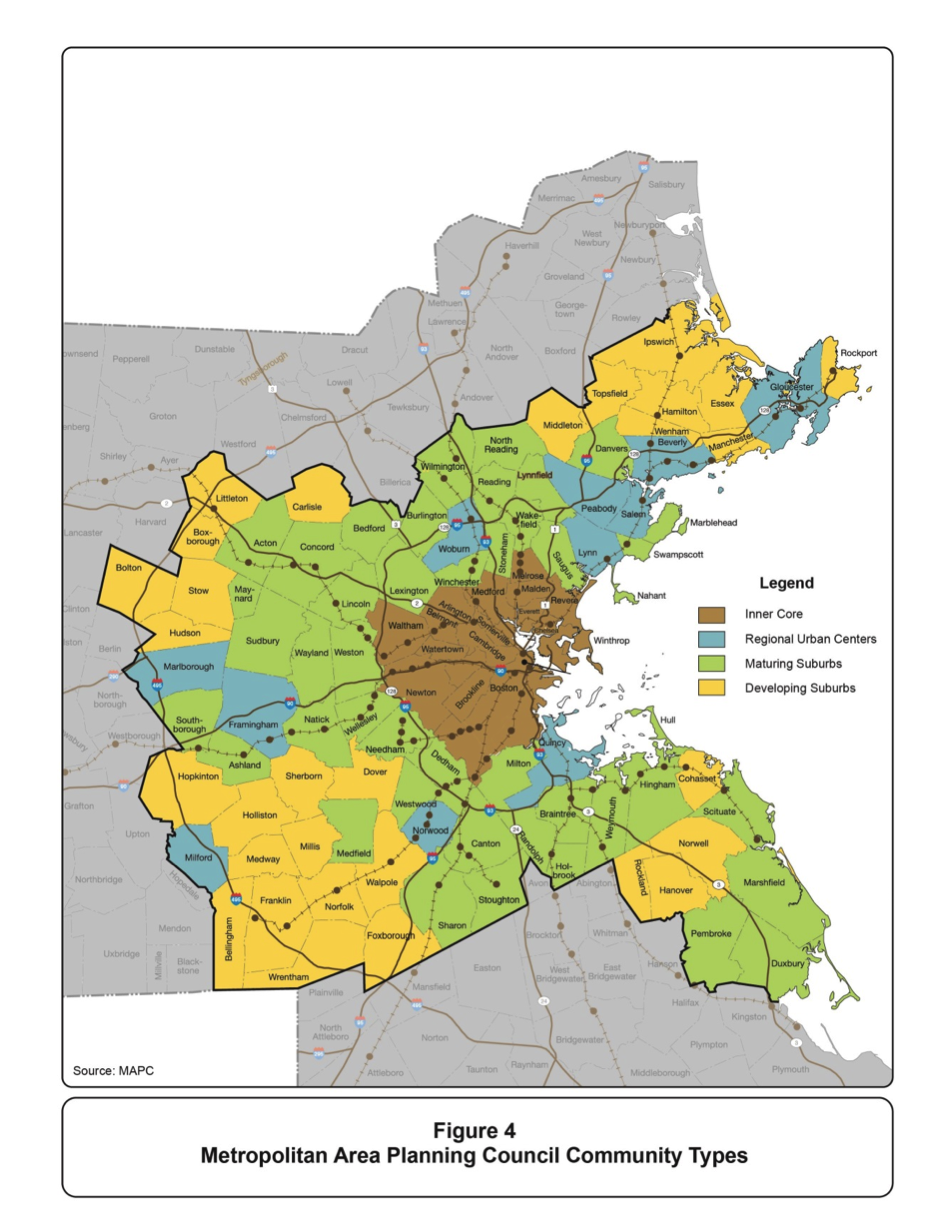
Chapter 3—Travel Patterns in the Boston Region MPO
An important part of understanding the MPO’s transportation needs is an understanding of the travel patterns in the region. The information used to analyze travel patterns for the Needs Assessment was obtained from several sources. Information on highway, transit, freight, bicycle, and pedestrian travel modes was derived from the MPO’s regional travel demand model, which uses base year (2012) conditions and projects future travel patterns. In addition, information from MPO studies and activities, including freight studies and the 2011 Massachusetts Travel Survey were used to obtain information on travel patterns in the region.
In developing the Long-Range Transportation Plan (LRTP), Charting Progress to 2040, the MPO conceptualized the region’s transportation needs over the next 25 years. Land use patterns, growth in employment and population, and trends in travel patterns will affect the demand on the region’s transportation system in different ways. In order to estimate future demands on the system for this LRTP, the MPO utilized its regional travel demand model set (referred to as the “model” throughout this report).1 The MPO's model, which is similar in nature to those used in most other large urban areas in North America, is a planning tool used to forecast and evaluate the impacts of transportation alternatives given varying assumptions with regard to population, employment, land use, and traveler behavior. The model is used to assess potential projects and programs in terms of air quality benefits, travel-time savings, and congestion reduction.
The model represents the transportation network in eastern Massachusetts, including all MBTA rail and bus lines, regional transit authority bus service, all private express-bus carriers, all commuter boat services, all limited-access highways and principal arterials, and many minor arterials and local roadways. Based on this network, the model simulates existing travel conditions and forecasts future-year travel on the transit and highway systems.
To obtain a more accurate picture of the travel demands in the Boston region, all communities in eastern Massachusetts are included in the modeled area: 101 municipalities in the MPO region and an additional 63 communities that are located outside of the MPO region. The modeled area is subdivided into more than 2,700 transportation analysis zones (TAZs), units of geography similar to census block groups.
The model simulates transportation supply characteristics and transportation demand for travel from every TAZ to every other TAZ in the modeled area. This simulation is the result of several inputs (different categories of data); the most important include population, employment, auto ownership, transit fares, automobile operating costs, highway and transit levels of service, and pedestrian and bicycle options. These inputs are updated on a regular basis to ensure the reliability of the forecasts. The MPO has incorporated many new procedures and capabilities into its model, including the ability to forecast nonmotorized trips (bicycle and pedestrian) and to utilize the parking capacities at MBTA stations to limit the number of drive-access transit trips reported in the model.
The model was used to estimate 2012 base-year travel conditions and project future-year 2040 No-Build travel conditions. No-Build conditions assume that there are no new improvements to the existing transportation system other than those that are currently under construction, advertised for construction, or included in the first year of the Federal Fiscal Years (FFYs) 2014–17 Transportation Improvement Program (TIP) of the Boston Region MPO and TIPs of adjacent MPOs.
Base- and future-year travel conditions were estimated for highway, transit, bicycle, and pedestrian travel into the Central Area and into the Boston Business District. The Central Area, as defined in this Needs Assessment, is the largest economic engine of the region; home to universities, hospitals, high-tech industries, retail establishments, and cultural institutions, providing the region with many jobs and other activities. The Central Area, shown in Figure 1, consists of most of Boston (excluding Hyde Park, Roslindale, West Roxbury, and Mattapan) and nine communities surrounding the city: Brookline, Cambridge, Chelsea, Everett, Malden, Medford, Revere, Somerville, and Winthrop. Many people travel into this area from surrounding municipalities, located both inside and outside of the MPO region.

The Boston Business District is the heart of the Central Area, shown in Figure 2. The Boston Business District’s boundaries are the Charles River to the north, Massachusetts Avenue to Interstate 93 (I-93) on the west and south, and the South Boston Seaport District bounded by Broadway from I-93 to Haul Road, and by New Cypher Street, D Street, and Summer Street from D Street to the Marine Industrial Site.

In addition, the model estimates travel for district-to-district groupings of communities’ travel patterns. All district-to-district travel is presented in terms of highway and transit person-trips. The 164-municipality model area (101 in the MPO region and 63 on its periphery) was divided into 41 districts in order to study the suburb-to-suburb travel patterns in the region. Travel patterns may be viewed in the LRTP Needs Assessment Application at www.bostonmpo.org/drupal/charting_2040_needs, which shows typical weekday travel between the suburban districts that are located outside of the Central Area.
Base-Year (2012) Travel into the Central Area
The Central Area is the Boston Region MPO area’s most prominent population and employment area. It is estimated that approximately 250,000 daily weekday person-trips2 enter the Central Area from the Boston Business District alone. Among all the regional trips destined to the Central Area, approximately 72 percent of person-trips have both their origin and destination within the Central Area, because of its large number of residents and employment opportunities. Approximately 735,000 daily person-trips enter the Central Area from all MPO corridors, including the Boston Business District. Approximately 52,000 weekday person-trips enter the Central Area from non-MPO municipalities. Detailed information about travel from specific corridors in the Boston Region MPO area into the Central Area may be found on the LRTP Needs Assessment Application, at www.bostonmpo.org/drupal/charting_2040_needs.
Accounting for 71 percent of all person-trips, highway travel is the predominant mode of travel into the Central Area. It is estimated that approximately 117,000 daily highway trips enter the Central Area from the Boston Business District alone, while the Northwest Corridor contributes approximately 105,000 daily trips to the Central Area. Approximately 66 percent of the total highway trips occurring throughout the MPO region have both their origin and destination within the Central Area. Overall, highway trips from other MPO corridors, including the Boston Business District, with the Central Area as their destination account for approximately 512,000 daily highway trips. An additional 48,000 daily trips enter from non-MPO municipalities3.
With approximately 317,000 transit person-trips on the average weekday, transit is the major mode of travel within the Central Area. Sixty-five percent of the transit trips within the Central Area use rapid transit (heavy rail and light rail), 33 percent use bus, 1.5 percent use commuter rail, and the remaining 0.5 percent use ferry. The Boston Business District contributes approximately 78,000 transit person-trips to the Central Area, the majority of which are made by rapid transit. Approximately 130,000 daily transit trips are destined to the Central Area from the remaining MPO corridors, including the Boston Business District, while approximately 4,000 transit trips enter the Central Area from non-MPO municipalities.
Bicycle trips are made mainly within the Central Area, with approximately 64,000 daily bicycle trips having both their origin and destination in the Central Area. The Boston Business District contributes approximately 12,000 bicycle trips to the Central Area each day, and 4,000 daily trips are from the Northwest Corridor. It is estimated that approximately 13,500 bicycle trips enter the Central Area from the MPO region overall, excluding the Boston Business District, with none entering from outside of the MPO region.
Walking is the second most prominent mode of travel within the Central Area, with an estimated 90 percent (623,000) of the total walk trips in the MPO area having both the origin and destination in the Central Area. The Boston Business District contributes approximately 43,000 walk trips to the Central Area, while other corridors contribute 24,000 walk trips to the Central Area. Many of these inter corridor trips to the Central Area originate within a close distance to the Central Area’s corridor boundaries.
Central Area: Projected Travel Trends – 2012 to 2040
The Central Area will continue to be the region’s most prominent population and employment area in 2040. Approximately 61,000 additional daily weekday person-trips are expected to enter the Central Area from the Boston Business District alone in 2040. The projections indicate that intraregional (both the origin and destination are in same region) person-trips for the Central Area will remain at 72 percent because of the large number of residents and employment opportunities in the area. Forecasts also indicate that an additional 139,000 daily person-trips will enter the Central Area from all the MPO corridors that are outside of the Central Area. There is a projected increase of 8,000 daily person-trips entering the Central Area from non-MPO municipalities.
Highway travel will continue to be the most prominent mode of travel into the Central Area in 2040. Daily highway trips into the Central Area from the Boston Business District are projected to increase by approximately 17,500 (15 percent), while daily highway trips from the Northwest Corridor will increase by 15,000 (14 percent). Highway trips having both their origin and destination in the Central Area are projected to increase by approximately 137,600 (13 percent). Highway trips to the Central Area from all MPO corridors outside of the Central Area are projected to increase by approximately 71,000 (13 percent); highway trips from non-MPO municipalities are projected to increase by 8,000 (16 percent).
Weekday daily transit trips within the Central Area are projected to increase by approximately 52,500. A 2 percent decrease in daily rapid transit trips and a 2 percent increase in commuter rail trips within the Central Area are projected for 2040. The model predicts that an additional 16,000 transit trips will enter the Central Area from the Boston Business District in 2040, and transit trips entering the Central Area from all other MPO areas, including the Boston Business District, are predicted to increase by approximately 26,000.
Daily bicycle trips within the Central Area are predicted to increase by 9 percent, or 5,500 trips. The model predicts that bicycle trips from the Boston Business District to the Central Area will increase by 1,000, with bicycle trips from the Northwest Corridor projected to increase by 1,000, and approximately 2,000 additional bicycle trips will enter the Central Area from the other MPO corridors by 2040.
Walking will continue to be the second-most prominent mode of travel within the Central Area by 2040. Intraregional walk trips are estimated to grow by approximately 29 percent, or 181,000 trips. Approximately 26,500 additional walk trips will enter the Central Area from the Boston Business District, while walk trips from all other MPO corridors are expected to increase by an additional 13,000 trips.
Base-Year (2012) Travel into the Boston Business District
On an average weekday, the total number of person-trips (auto, transit, bicycle, and pedestrian) entering the Boston Business District from all other areas of the Boston Region MPO is approximately 448,000, with approximately 48,000 person-trips from non-MPO municipalities. Travel within the Boston Business District itself is high, with 40 percent of the total person-trips destined to the Boston Business District (approximately 335,000), also originating within the Boston Business District. Detailed information of travel from specific corridors in the Boston Region MPO into the Boston Business District may be found on the LRTP Needs Assessment Application at www.bostonmpo.org/drupal/charting_2040_needs.
The majority of highway trips estimated to enter the Boston Business District are from the Central Area with approximately 113,000 trips. On an average weekday, approximately 256,000 trips are estimated to enter the Boston Business District from other MPO corridors including the Central Area, with approximately 42,000 highway person-trips from municipalities outside of the MPO region.
Transit is the second most prominent mode of travel within the Boston Business District, with approximately 98,500 weekday daily transit person-trips having both ends in the Boston Business District. Among these trips the majority of daily person-trips, or approximately 73,000 trips, are on rapid transit, 24,000 trips are on bus, 1,400 trips are on commuter rail, and 100 are on ferry. Approximately 84,000 transit trips enter the Boston Business District from the Central Area, with approximately 132,500 transit trips from other corridors in the MPO, including the Central Area. Approximately 6,000 transit trips enter the Boston Business District from non-MPO municipalities located outside of the MPO region.
It is estimated that approximately 12,000 daily bicycle trips enter the Boston Business District from the Central Area. This is approximately 43 percent of the total daily bicycle trips destined to the Boston Business District. Approximately 10,000 daily bicycle trips are wholly within the Boston Business District. The remaining MPO corridors contribute 6,000 total bicycle trips to the Boston Business District.
Walking is the most prominent mode of travel within the Boston Business District. Approximately 81 percent of the MPO region’s weekday daily walk trips are observed within this district. The Central Area contributes approximately 41,000 walk trips to the Business District.
Boston Business District: Projected Travel Trends—2012 to 2040
In 2040, the model predicts that the total number of weekday person-trips entering the Boston Business District from all other corridors in the Boston Region MPO will increase by approximately 18 percent or 82,400 trips and by approximately 10 percent or 5,000 trips from non-MPO municipalities that are located outside of the MPO region. Travel totally within the Boston Business District is expected to increase by approximately 92,000 between 2012 and 2040.
The Central Area will continue to contribute the majority of highway person-trips entering the Boston Business District, with an additional 17,000 trips during the base year (2012). With the exception of the Boston Business District, there is a projected increase of 25,000 highway trips from all MPO corridors, while highway trips from non-MPO municipalities are forecast to increase by 3,000.
With 27 percent of total trips, transit continues to be the second most prominent mode of travel within the Boston Business District. The model predicts that approximately 15,500 additional weekday daily transit person-trips will occur within the Boston Business District. Rapid transit trips are predicted to increase by an additional 12,000, bus trips by an additional 3,000, and commuter rail trips by 500. Transit trips from all other MPO corridors outside of the Boston Business District are predicted to increase by approximately 29,000, while transit trips from non-MPO municipalities are predicted to increase by approximately 2,000.
Daily bicycle trips entering the Boston Business District from the Central Area are predicted to increase by approximately 1,000 or 8 percent by 2040. The model predicts that total daily bicycle trips that are within the Boston Business District will increase by 1,200, and approximately 1,500 bicycle trips will enter the Boston Business District from all other MPO corridors (including the Central Area).
In the base year (2012), walk trips accounted for 53 percent of person-trips within the Boston Business District. By 2040, walking continues to be the most predominant mode of travel. It is projected that daily weekday walk trips occurring within the Boston Business District will increase by an additional 66,000, and that walk trips from the Central Area to the Boston Business District will increase by approximately 26,000.
Base Year (2012)
One clear trend of district-to-district travel (highway and transit trips only) estimated by the model is that most travel (52 percent) occurs completely within districts (the districts are shown in Figure 3). This is not unexpected, considering that more than 60 percent of trips in the region are shorter than five miles. While the largest intra-district flow in the region exceeds 250,000 person-trips per day, the highest trip flow between adjacent districts is only 42,800 trips per day. The typical weekday travel between nonadjacent districts seldom exceeds 10,000 trips.
 The five highest MPO-area suburban district-to-district trip flows include:
The five highest MPO-area suburban district-to-district trip flows include:
Projected Future-Year (2040) District-to-District Travel
As is the case for the base year, most travel occurs within districts. The top intra-district flow in the region is predicted to increase by 70,000 daily person-trips (highway and transit person-trips only). The highest trip flow between adjacent districts is forecast to increase from 42,800 trips to 53,500 trips.
The five highest suburban district-to-district trip flows presented above are predicted to remain the same in 2040. Trips for each of these five district-to-district pairs are expected to increase by approximately 23 to 25 percent.
The MPO conducts a variety of studies and activities that provide information on the travel patterns in the region. Some of the information presented below was obtained from the MPO’s freight-planning activities and studies conducted since 2007. In addition, information on bicycle and pedestrian travel was extracted from the 2011 Massachusetts Travel Survey.
Description of Freight Movement in the Boston Region MPO
Efficient motor freight transportation contributes to a vibrant economy. This requires suitable infrastructure, operations, and policies. Most goods manufactured outside of the MPO region and delivered to the region are transported by one of the following methods:
Freight transportation relies on the same road and rail networks that people use to access their everyday needs. These networks are often congested at peak hours and have acute maintenance needs. Therefore, increases in freight volume may affect system performance for both freight transport and passenger travel.
Forecasts prepared using the Truck Trip Generation component of the Boston Region MPO’s regional travel demand model predicts that the number of truck trips that begin and/or end in the region will increase by about 18 percent, and the number of truck trips with both trip ends in the region will increase by approximately 13 percent between 2010 and 2040. In the same time period, trips with one or both ends outside of the MPO region are expected to increase by roughly 44 percent (trips with one or both ends outside of the MPO region show a higher growth rate, but are a much smaller proportion of all trips). This growth would have a significant impact on the highway system.
The Massachusetts Freight Plan (MassDOT, September 2010) predicts that the share of freight moving by trucks will increase in the future, but the use of other freight modes will also increase significantly. The Massachusetts State Freight Plan and Massachusetts State Rail Plan (MassDOT, September 2010) recommend making several investments that would support shifting freight transport, when feasible, from trucks to trains and ships in order to mitigate some of the effects of trucking in Massachusetts. While increasing the share of freight moved by other modes would yield benefits for the region’s road network, long-term growth in freight traffic still would result in increased numbers of trucks, which would continue to distribute the vast majority of freight within the Boston Region MPO area.
The MPO conducted a freight study, which was published in 2012, that profiled the impact of trucks in the region. The primary purpose of this study was to examine how, where, and to what extent trucks affect the region’s transportation system. It produced a profile of truck impacts in the region, with a focus on highway volumes and crashes that involve trucks. The following section presents information from that study on truck travel, in addition to updated data on truck travel in the region.
Analysis of Truck Travel in the Boston Region MPO Area
Trucks are the dominant freight mode in the Boston Region MPO area. They operate on all of the roadways in the region, for both long-distance movement of goods and local deliveries. In this analysis, trucks are defined as vehicles with six or more wheels, excluding buses. Numerous four-wheeled pickup trucks and vans also support regional commerce. These are reflected in the model but are not considered trucks in this analysis.
A review of recent truck-specific traffic counts and modeled traffic data reveals certain truck travel patterns. Some of the heaviest truck traffic, both in absolute numbers and as percent of total traffic, is found on I-495. Over 20,000 trucks each weekday travel over its northwest arc, which serves as the key truck corridor connecting the Middle Atlantic region with northern New England. Slightly fewer trucks share the Route 128/I-95 circumferential highway, with a significantly higher number of autos, resulting in a lower percentage of trucks. The radial express highways shed trucks as they approach Boston, with about 10,000 passing through downtown Boston on I-93 and slightly fewer on I-90 each weekday.
The highways with the highest truck volumes in the MPO region are:
Bicycle travel in the Boston Region, as estimated by the travel demand model, was described in Section 2, above. In addition to modeled data, the Boston Region MPO staff obtained information about travel into and within the MPO region through the 2011 Massachusetts Travel Survey. The survey provided information on nonmotorized modes of travel, which was used to estimate the amount of bicycle travel in specific areas, described below. Almost 700 survey respondents statewide reported making a total of 1,680 daily trips by bicycle.
The survey data were further analyzed by community type. The Metropolitan Area Planning Council (MAPC) developed a set of descriptions of community types, as Shown in Figure 4, which is used to provide context for understanding regional land use issues and trends. MAPC’s four community types are described below, along with the findings from the 2011 Massachusetts Travel Survey on bicycle travel within each type of community.

Pedestrian travel in the Boston region, as estimated by the regional travel demand model, was described in Section 2, above. In addition, the MPO staff obtained information about travel into and within the MPO region through the 2011 Massachusetts Travel. The survey collected information on all modes of travel, including the pedestrian mode.
Walking is an important transportation mode in the MPO region; it is used extensively both to travel between activities and to connect to other modes as part of longer journeys. The data available in the 2011 Massachusetts Travel Survey allow walk activity to be quantified, and the mode’s importance to the various regional communities to be compared and analyzed as follows:
1 The regional travel demand model set is made up of four component models, each of which simulates a step in the travel decision-making process.
2 A trip by one person in any mode of transportation.
3 Municipalities located outside of the 101 municipalities in the Boston Region MPO but within the MPO’s travel demand model area.
4 Miles traveled on bicycle.